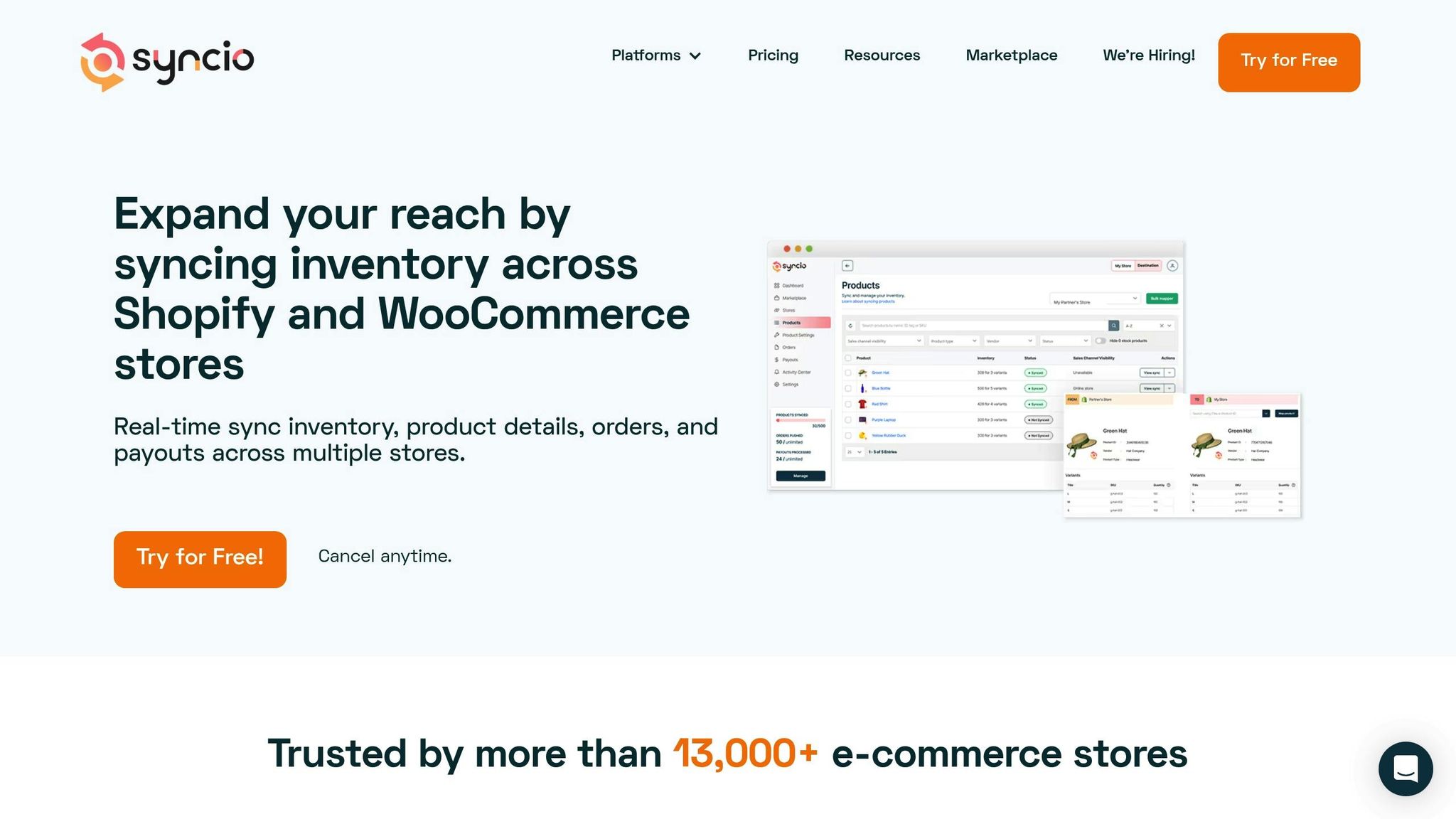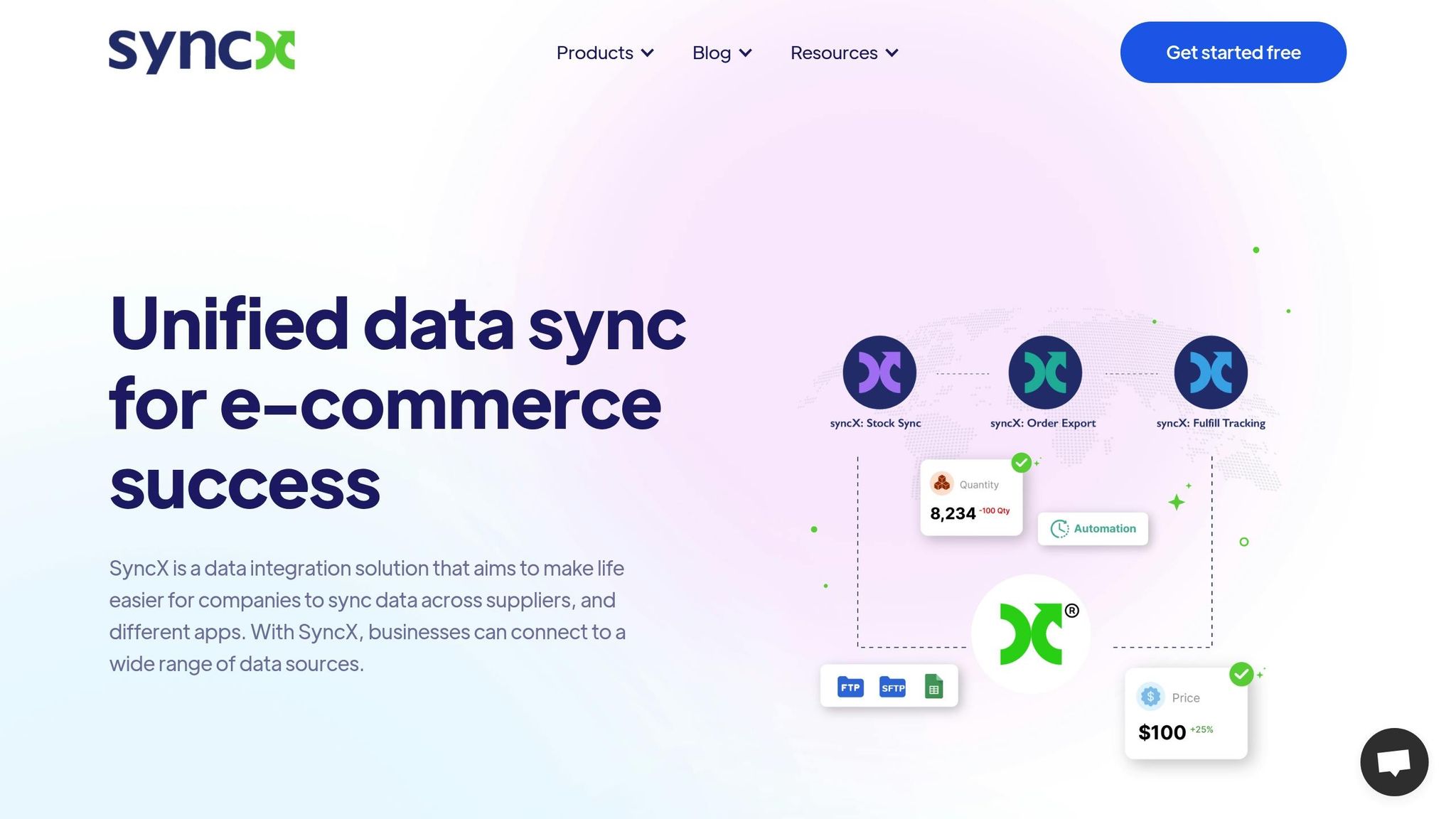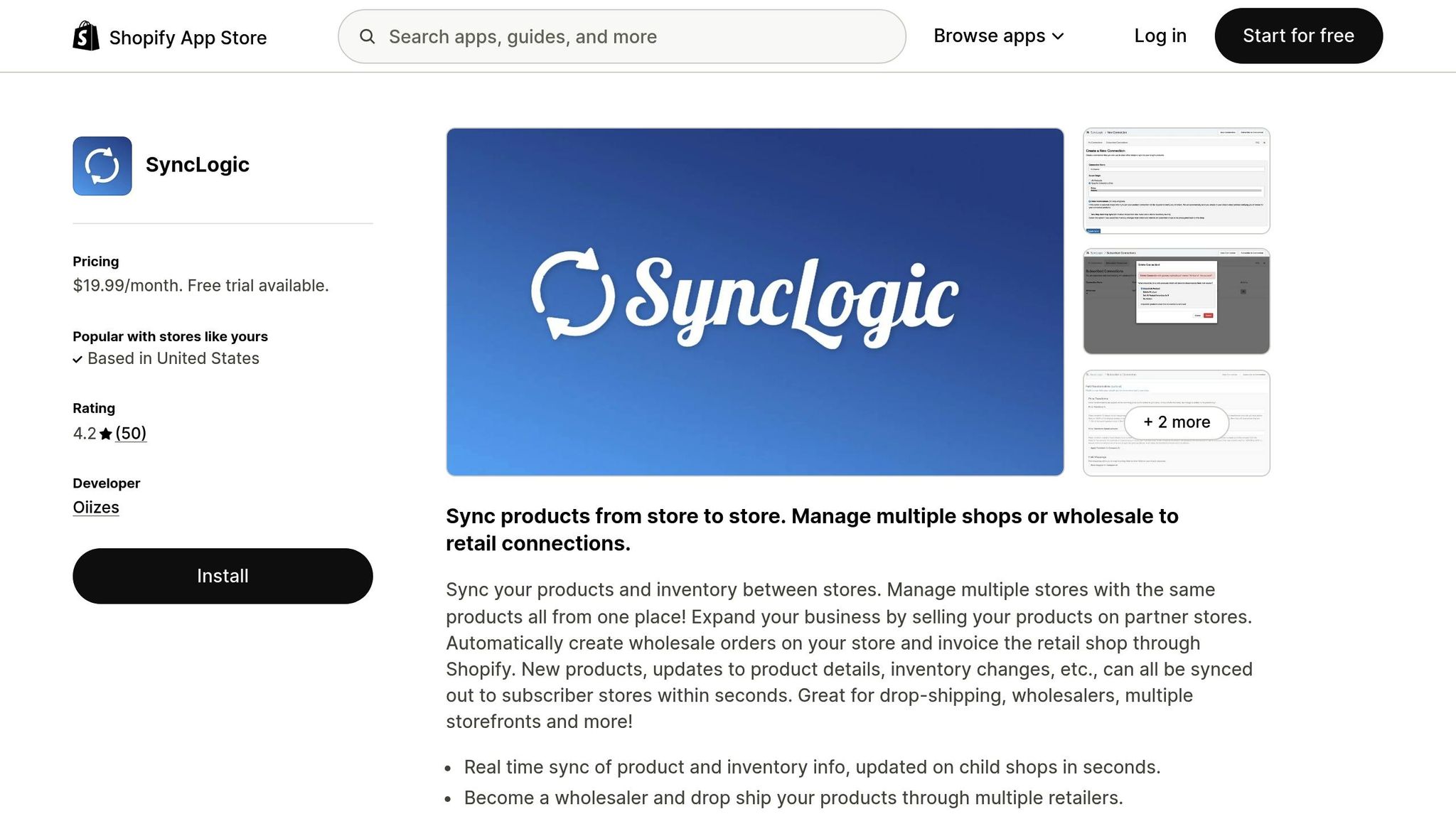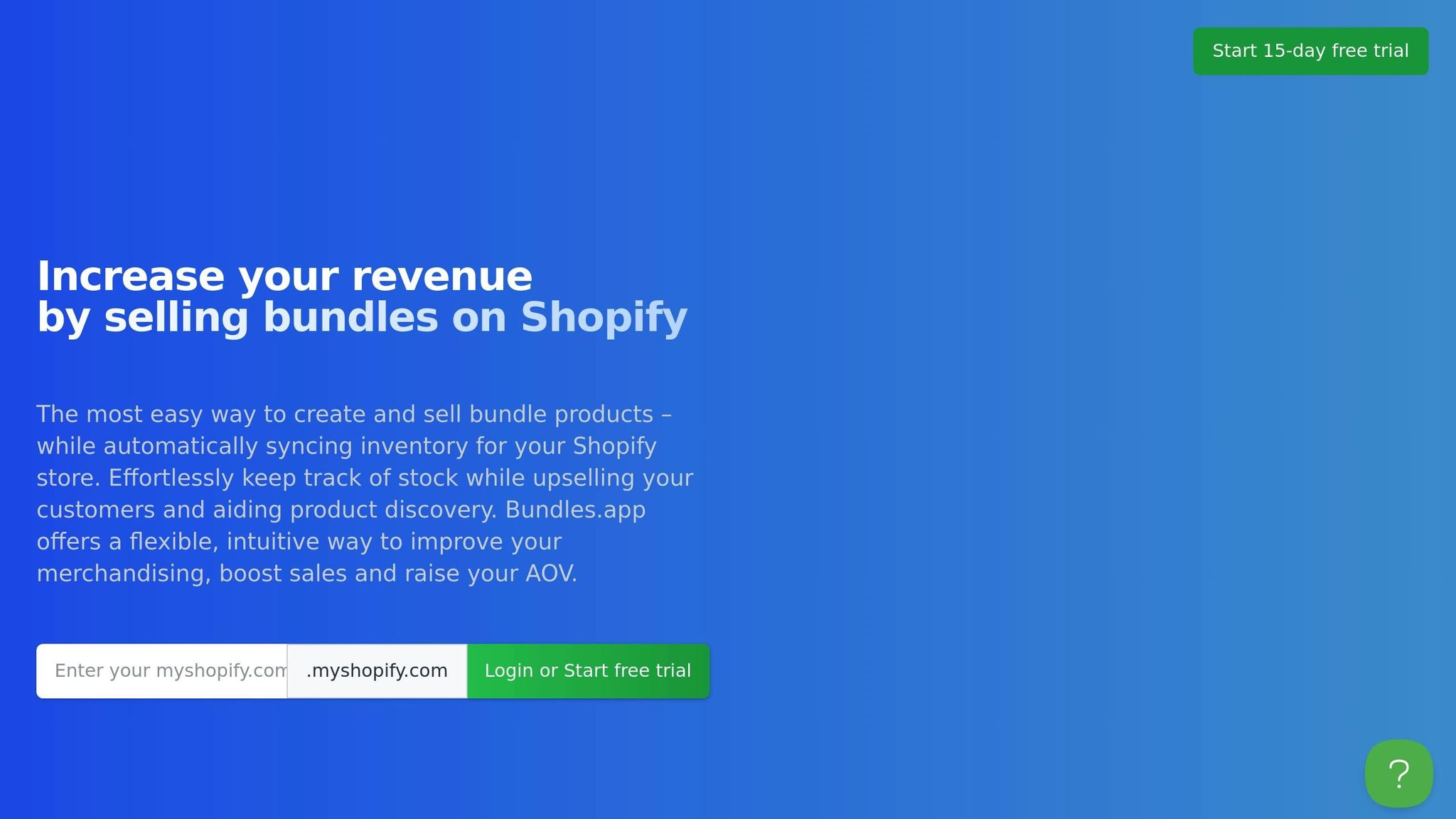Managing inventory across multiple sales channels is a challenge for Shopify merchants. Real-time stock synchronization tools are essential for avoiding overselling, canceled orders, and customer dissatisfaction. These tools ensure inventory updates happen instantly across platforms, saving time and reducing errors. Here are five tools to consider, each offering unique features and pricing:
- Forstock ($39/month): Offers AI-driven demand forecasting, automated purchase orders, and multi-location tracking. Ideal for businesses seeking advanced analytics and automation.
- Syncio Multi-Store Sync ($19/month): Focuses on syncing inventory across multiple Shopify stores with real-time updates and centralized control.
- Stock Sync ($9/month): Simplifies bulk inventory updates and integrates with supplier systems using CSV, XML, or APIs.
- SyncLogic ($29/month): Connects Shopify with marketplaces like Amazon and eBay for real-time multi-channel inventory management.
- Bundles.app ($9.99/month): Perfect for managing product bundles by syncing component-level stock updates.
These tools cater to various business needs, from multi-store operations to managing supplier feeds or product bundles. Choose the one that aligns with your inventory challenges to improve efficiency and accuracy.
Quick Comparison:
| Tool | Starting Price | Key Features | Best For |
|---|---|---|---|
| Forstock | $39/month | AI forecasting, supplier management, multi-location tracking | Advanced automation and analytics |
| Syncio | $19/month | Multi-store sync, centralized inventory control | Multi-store operations |
| Stock Sync | $9/month | Bulk updates, supplier integration | Simplifying supplier feeds |
| SyncLogic | $29/month | Marketplace integration, real-time updates | Multi-channel retailers |
| Bundles.app | $9.99/month | Bundle management, component-level sync | Managing product bundles |
Each tool offers specific benefits to help you maintain accurate inventory and streamline operations.
Multi Store Sync Shopify Apps

1. Forstock

Forstock is an inventory management platform tailored for Shopify brands, designed to simplify and synchronize stock management. At $39 per month, this SaaS tool offers more than just basic inventory tracking - it provides a comprehensive solution to streamline operations and keep stock levels in check. Let’s dive into what makes Forstock stand out.
Real-time inventory updates
Forstock’s real-time inventory dashboards give merchants instant visibility into stock levels across all locations. With seamless Shopify integration, inventory updates are automatically reflected across all sales channels, ensuring accuracy and consistency.
One standout feature is Stock Intelligence, part of the platform’s Inventory Table. This tool not only displays stock levels but also delivers performance insights, helping merchants track stock movements, pinpoint fast-moving products, and identify potential issues before they disrupt sales.
Multi-store and multi-channel support
For businesses managing multiple Shopify stores or selling across various platforms, Forstock offers unified inventory tracking. It consolidates data from retail and online channels into a single, easy-to-navigate dashboard. This makes managing complex, multi-location operations far less daunting.
The platform’s robust API ensures seamless inventory updates between different systems and locations. Whether you’re juggling inventory for one Shopify store or several retail outlets, Forstock keeps stock levels consistent and simplifies supplier coordination.
Automated supplier integration
Managing suppliers manually can be a hassle, but Forstock automates the process. It generates purchase orders automatically based on pre-set stock levels and parameters, eliminating the guesswork around reordering products.
The supplier management feature centralizes vendor communication and order tracking, offering visibility from the initial purchase order to delivery. This streamlined approach ensures transparency and keeps the supply chain running smoothly.
Data-driven analytics and forecasting
Forstock doesn’t just track inventory - it helps you plan for the future. Using AI-driven analytics, the platform provides highly accurate forecasting, taking into account sales trends, lead times, and seasonal demand. This allows merchants to make smarter purchasing decisions based on data rather than instinct.
With 12-month demand plans, merchants gain long-term insights into their inventory needs. These plans include reorder suggestions and safety stock recommendations, helping businesses optimize cash flow while avoiding overstocking or stockouts.
The analytics dashboard breaks down complex inventory data into actionable insights. It highlights which products are driving profits and which are tying up valuable resources, empowering merchants to reduce manual inventory tasks and improve overall cash flow management.
2. Syncio Multi-Store Sync

Syncio is designed to keep inventory in sync across multiple Shopify stores. Starting at $19 per month, it simplifies multi-store inventory management with a focus on real-time updates and flexibility.
Real-time inventory updates
Syncio uses a hub-and-spoke model, where one main store acts as the central hub for inventory. Connected stores automatically receive updates whenever there’s a change, ensuring stock levels stay accurate. With webhook technology, inventory adjustments happen instantly after a sale, reducing the risk of overselling and making fulfillment more efficient. This real-time system is especially useful for businesses managing multiple stores, providing a dependable framework for seamless operations.
Multi-store and multi-channel support
Syncio is well-suited for businesses with complex store setups, such as supplier-retailer networks, franchises, or multi-brand operations. Merchants can choose to sync specific products or collections, allowing them to share inventory across stores while maintaining unique product offerings in each location.
The platform also supports variant-level synchronization, ensuring accurate stock counts for different sizes, colors, or styles. It even syncs product variants and pricing between stores. For larger operations, higher-tier plans allow unlimited store connections, making it ideal for franchises or businesses with extensive networks. Each connection can be customized with specific rules for syncing products, pricing, and inventory thresholds, offering a tailored solution for diverse business needs.
3. Stock Sync

Stock Sync simplifies the process of managing supplier feeds and bulk inventory updates, making it an essential tool for businesses juggling multiple suppliers or handling large amounts of inventory data.
Automated Supplier Integration
Stock Sync is designed to integrate seamlessly with supplier systems, supporting a variety of data formats like CSV, XML, and API connections. It can automatically retrieve inventory updates from suppliers at scheduled intervals - whether hourly, daily, or weekly - based on your business requirements.
The platform works with FTP and API connections to process inventory, pricing, and product data, catering to both traditional wholesalers and dropshipping suppliers. This automation eliminates the need for manual file downloads and tedious, individual updates.
One standout feature is automated mapping. If your supplier’s product codes don’t align with your Shopify SKUs, Stock Sync can automatically create mappings to bridge the gap. This is especially helpful for businesses sourcing identical products from multiple suppliers or using their own internal SKU systems. Combined with real-time updates, this feature ensures accurate and efficient inventory management.
Real-Time Inventory Updates
Stock Sync processes supplier feeds as scheduled and uses webhooks to synchronize inventory instantly. This means that as soon as a sale is made, inventory levels are updated across all connected channels, reducing the risk of overselling.
The platform also offers advanced conditional rules. For example, you can set minimum and maximum thresholds to avoid discrepancies in stock levels. Additionally, you can establish maximum inventory limits to prevent displaying unrealistic stock quantities caused by supplier data errors.
Another key feature is variant-level management, which ensures accurate tracking of different sizes, colors, and configurations. Beyond real-time updates, Stock Sync extends its capabilities to businesses operating across multiple stores and sales channels.
Multi-Store and Multi-Channel Support
For merchants managing several Shopify stores, Stock Sync enables multi-store inventory distribution. It can take a single supplier feed and allocate inventory across multiple stores based on pre-set rules. For instance, you could assign 60% of incoming inventory to your main store and 40% to a secondary outlet.
Stock Sync also integrates with a range of sales channels beyond Shopify, like Amazon and eBay. This means that a single inventory update from your supplier can sync across all your platforms, keeping stock levels consistent everywhere. If a product sells on Amazon, Stock Sync will immediately update inventory on Shopify and other connected channels.
For businesses with complex inventory needs, the platform offers advanced distribution options. You can prioritize specific stores or channels, set unique safety stock levels for each location, or exclude certain products from particular stores. This flexibility makes Stock Sync an excellent choice for businesses with franchises, multiple brands, or region-specific inventory requirements, ensuring smooth and accurate stock management across all channels.
sbb-itb-f0fc809
4. SyncLogic

When exploring tools for real-time inventory synchronization, it's worth noting that not all options come with detailed public documentation. SyncLogic is one such tool available on Shopify, designed to sync inventory in real time. However, specific details about its features and integrations aren't widely disclosed. For the most accurate and up-to-date information, it's best to reach out directly to the provider.
5. Bundles.app - Inventory Sync

Bundles.app simplifies inventory management for product bundles and kits by automatically adjusting availability based on the stock levels of individual components. If one component runs out of stock, the entire bundle is marked as unavailable for purchase.
Real-time inventory updates
This app keeps bundle and component inventories in sync, ensuring you never accidentally sell incomplete bundles. It’s particularly useful for managing bundles with overlapping components. For instance, if a phone case is part of both a "Protection Bundle" and a "Complete Accessories Kit", Bundles.app tracks sales across all combinations, updating inventory in real time to reflect changes.
Multi-store and multi-channel support
For merchants with multiple Shopify stores, Bundles.app offers the ability to synchronize inventory across different storefronts. This feature is ideal for businesses with separate stores for various markets or product lines that share a common inventory. It integrates seamlessly with Shopify’s native inventory tracking, maintaining consistent availability across all storefronts and sales channels.
Pricing for Bundles.app starts at $9.99/month for basic bundle management. Higher-tier plans include advanced inventory features and unlimited bundle combinations, with costs scaling based on the number of bundles and the complexity of your inventory needs.
Feature and Price Comparison
Below is a handy table summarizing the standout features and pricing of top real-time stock sync tools for Shopify. Use this quick guide to find the right fit for your store's needs.
| Tool | Starting Price | Key Features | Best For |
|---|---|---|---|
| Forstock | $39/month | ✓ AI-powered demand forecasting (95% accuracy) ✓ Automated purchase order creation ✓ 12-month demand planning ✓ Supplier management dashboard ✓ Multi-location inventory tracking |
Brands prioritizing demand forecasting and automation |
| Syncio Multi-Store Sync | $19/month | ✓ Multi-store inventory synchronization ✓ Automated stock level updates ✓ Centralized inventory control ✓ Real-time sync across storefronts |
Multi-store operations and franchises |
| Stock Sync | $9/month | ✓ CSV/XML file imports ✓ Scheduled automatic updates ✓ Bulk inventory management ✓ Third-party system integration |
Businesses using external inventory systems |
| SyncLogic | $29/month | ✓ Real-time multi-channel sync ✓ Marketplace integration (Amazon, eBay) ✓ Automated inventory adjustments ✓ Cross-platform stock management |
Multi-channel retailers selling on multiple platforms |
| Bundles.app | $9.99/month | ✓ Bundle inventory management ✓ Component-level stock tracking ✓ Multi-store bundle sync ✓ Automatic availability updates |
Stores that sell product bundles or kits |
This table highlights the core strengths of each tool alongside their pricing, helping you make an informed decision based on your business requirements.
Forstock stands out for its advanced features like AI-driven demand forecasting, automated purchase orders, and multi-location tracking, all for a flat $39/month. On the other hand, Stock Sync and Bundles.app offer essential sync capabilities at budget-friendly prices of $9–$10/month. Meanwhile, Syncio and SyncLogic cater to more complex needs, such as multi-store and multi-channel operations, with pricing ranging from $19 to $29/month.
If your business operates multiple storefronts, Syncio is a strong contender with its specialized multi-store synchronization. For those managing inventory across platforms like Amazon, eBay, and Shopify, SyncLogic provides seamless marketplace integration to keep everything in sync.
For businesses seeking scalability without unexpected costs, Forstock is an appealing choice. Its flat pricing structure ensures no additional charges as your sales grow, while its AI-powered tools and automation significantly reduce manual tasks, making the $39/month investment worthwhile.
Conclusion
Keeping inventory in sync in real time has become a game-changer for Shopify merchants. It helps prevent overselling, ensures accurate stock levels, and keeps your inventory aligned across multiple sales channels. Without it, businesses risk running into stockouts, overstocking, or misaligned inventory - issues that can seriously hurt profits.
The tools we’ve covered each address specific inventory management challenges. Forstock stands out with its AI-powered demand forecasting and 12-month planning features. Syncio is perfect for merchants managing multiple Shopify storefronts, while Stock Sync offers a cost-effective way to integrate external inventory systems. For those juggling multiple sales channels, SyncLogic connects Shopify stores with marketplaces seamlessly. And if you deal with product bundles, Bundles.app is a solid choice for keeping kits organized and inventory accurate. These tools don’t just simplify inventory management - they directly boost efficiency and profitability.
In fact, according to data, businesses that adopt proper synchronization tools see a 60% drop in stockouts. The key is choosing a tool that fits your business needs - whether it’s basic syncing or advanced AI-driven forecasting. With the right solution, you’ll reduce errors, streamline your operations, and set your Shopify store up for long-term growth.
FAQs
What are the benefits of real-time stock synchronization for Shopify merchants managing inventory across multiple channels?
Real-time stock synchronization allows Shopify merchants to keep their inventory accurate and up-to-date across all sales channels. This helps prevent issues like overselling or running out of stock, ensuring customers can rely on product availability and reducing the chance of missed sales opportunities.
By automating inventory updates, merchants save time, cut down on manual errors, and simplify their workflows. Plus, having a clear view of stock levels supports smarter planning and more efficient inventory management. In the end, real-time synchronization not only boosts customer satisfaction but also helps businesses operate more smoothly and grow effectively.
What features make Forstock ideal for automating inventory management on Shopify?
Forstock equips Shopify businesses with tools that simplify inventory management and enhance efficiency. It offers real-time demand forecasting, AI-powered alerts to help avoid stockouts, and automated purchase order creation to save time and reduce mistakes.
With its centralized dashboard, you can keep an eye on inventory levels, analyze performance across various locations, and make informed decisions based on sales trends and lead times. By automating repetitive tasks and consolidating supplier communication, Forstock ensures you can meet demand effectively while optimizing cash flow and overall operations.
What should businesses consider when choosing a real-time stock sync tool for their Shopify store?
To find the best real-time stock sync tool for your Shopify store, prioritize how well it works with Shopify and any other systems you already use. Key features to look for include real-time inventory updates, automated reporting, and the ability to manage stock across multiple locations or sales channels. These features help keep your inventory accurate and your operations running smoothly.
You’ll also want to think about how user-friendly the tool is and whether it can handle the unique demands of your inventory. For instance, can it manage a complex product catalog or adapt to seasonal changes in stock? The ideal tool should not only simplify your inventory management but also save you time and provide insights that help you meet customer demands efficiently.



.png)
.png)



.png)
.png)
.png)
.svg)